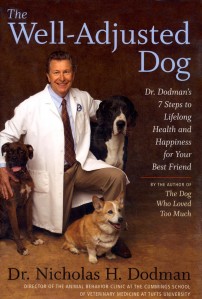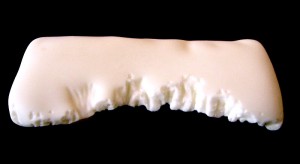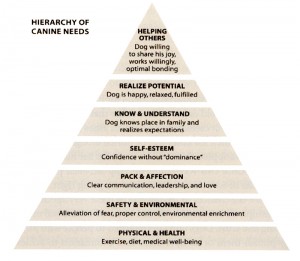What’s This? A Brain-Bending, Eyeball Twisting Photo Quiz
April 29, 2009
Use the skills you’ve gained, America, from countless hours of watching police forensic procedurals (click on image for larger view).
I will give you only the following clues: it’s a common house-hold object, no bigger than a bread box, most people use one every day, some people say it is 99 and 44/100ths pure.
This space will substitute for the musical interlude which limits your time to consider the question to, oh, just about. . . now!
Give up? It’s a Labrador Soap Carving by our three year old black female, Luna. Number two, of an unlmited edition.
Best, Short Dog Book Ever – Nicholas Dodman’s “The Well-Adjusted Dog”
March 17, 2009
 Dr. Nicholas Dodman, Director of the Animal Behavior Clinic at the Cumming School of Veterinary Medicine at Tufts University has produced a small gem of a book, The Well-Adjusted Dog.
Dr. Nicholas Dodman, Director of the Animal Behavior Clinic at the Cumming School of Veterinary Medicine at Tufts University has produced a small gem of a book, The Well-Adjusted Dog.
There’s more good, solid information in its 250 pages than in a whole host of other books written by dog ‘experts’ who have little or no credentials in the science and study of canines (Cesar Milan, I’m looking at you).
“Your job as a dog owner,” Dodman writes “is to try and understand your dog’s life fro his point of view, and to lead and protect, not to dominate, punish, and force a dog into submission, as popularized on too many of today’s TV shows.”
When this book comes out in paperback, I can see giving out multiple copies to neighbors and fellow dog owners, rather than trying to answer their questions myself.
One of the first and most vital points he makes is his belief that most dogs are under-exercised and bored out of their minds. (From my own experience I think this analysis is on the money). This leads to a multitude of behavioral problems including barking, inappropriate chewing, aggression, tail chasing, licking to the point of skin damage and more.
The average dog needs a minimum 30 minutes of aerobic exercise a day, every day. How many dogs do you know that meet that requirement?
Given that behavioral problems are the primary reason dogs are surrendered to shelters (the majority of whom are fated for euthanasia/destruction) proper handling of these issues may be essential to save the life of someone’s pet.
What I especially appreciate is his easy prose style and the clarity of his thinking even in controversial areas like herbal treatments and nutraceuticals. Here’s a sample of his writing about alternative medicine for dogs:
“Homeopathy—wherefore art thou, homeopathy? Though it’s popular in Europe, I have serious concerns about this branch of alternative medicine. The theory, of course, is that a little does of what ails you does you good. I can see how the concept applies to vaccination and desensitization to allergens, because inoculates stimulate an immune response—but I can’t see how it applies in other situations. Various homeopathic behavioral remedies containing microscopic concentrations of herbal products are now on the market.”
“One such remedy — anti-anxiety drops— was originally developed by an Irish veterinary practitioner who whipped up a dilute concoction of herbs to treat mastitis (inflammation of the udder) in cows. Being a large-animal vet, cows and mastitis were dear to his heart. In a moment of brilliance, he decided to bottle the cattle remedy for use in dogs to treat what else but . . .anxiety. And thus anti-anxiety drops were created. Whether the product actually works is doubtful, but bottles of the stuff are flying off the shelves. Naturopaths are positively swarming for it. Testing of this product presumably went like this:
- Take a worried-looking, baking dog and film him.
- Put the anxiety drops on his tongue.
- Wait until he has calmed down.
- Film him again.
- He’s calm.
- It’s a miracle!
The point they seemed to miss is that the only mental state that can follow a disturbed one is calm. It’s just a matter of time. I sent a sample of the anti-anxiety drops to the Department of Biochemistry and Experimental Therapeutics at Tufts medical school to see whether I ws missing something about the ingredients. The reply came back, ‘Nick, there’s virtually nothing here. It’s water.’ I guess that’s the point.”
Dodman also has constructed a pyramid Hierarchy of Canine Needs (adapted from psychologist Abraham Maslow’s triangle of human needs) that neatly summarizes what you as a caring dog owner should be striving towards. See how close you are coming to these goals with your own dog. Click image for larger size.
The bottom line: Buy This Book!
Supplements Glucosamine/Chondroitin Don’t Work Any Better than a Sugar Pill
January 14, 2009
Dr. Donna Raditic’s column (“Nutraceutical News”) in the Jan./Feb. 2009 of The Bark should be praised for emphasizing the point that “natural”is not always harmless. But I have to take issue with her very first recommendation: glucasamine and chondroitin supplements for ‘joint health.’
As the owner/guardian of two Labs and the spouse of an individual who suffered from hip dysplasia for 15 years and has had two hip replacements, I’ve learned a couple of things about these two supplements: they are enormously profitable for their distributors and their effectiveness is open to serious doubt.
The largest controlled clinical trial of glucasamine and chondroitin by the National Institutes of Health concluded that they don’t work any better than a sugar pill at halting the destruction of cartilage. The full report is available online from Arthritis & Rheumatism, the official monthly journal of the American College of Rheumatology, Sept. 29, 2008.
Dr. Ali Askari, chief of rheumatology at University Hospitals Case Medical Center, put it this way in discussing the study, “The bottom line is that there is no specific difference between the placebo and the glucosamine/chondroitin mix.”
The bottom line for concerned dog owners? Research your supplements carefully.
Pet Owners: Live Longer & Healthier?
October 22, 2008
How Stuff Works weighs in on the subject of the health benefits of pet ownership, here. We’ve written about this topic before and there are dissenting opinions of precisely how much of a benefit there may be.
When looking at this I think it is wise to always remember these words of Bertrand Russell from 1959:
“When you are studying any matter never let yourself be diverted either by what you wish to believe, or by what you think would have beneficial social effects if it were believed. Look only and solely at what are the facts.”
Huxley’s Paw at 6 Years Old
April 6, 2008
Animals in the Womb: Amazing Photography by National Geographic
April 2, 2008
These photos of dog embryos in various stages of development are from a series done in 2006 for National Geographic called Animals in the Womb. Here’s a link to a gallery hosted by Der Speigel Online with 12 incredible images: photo gallery.
Please click on the thumbnails below for larger images.








